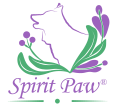What is Tellington TTouch®?
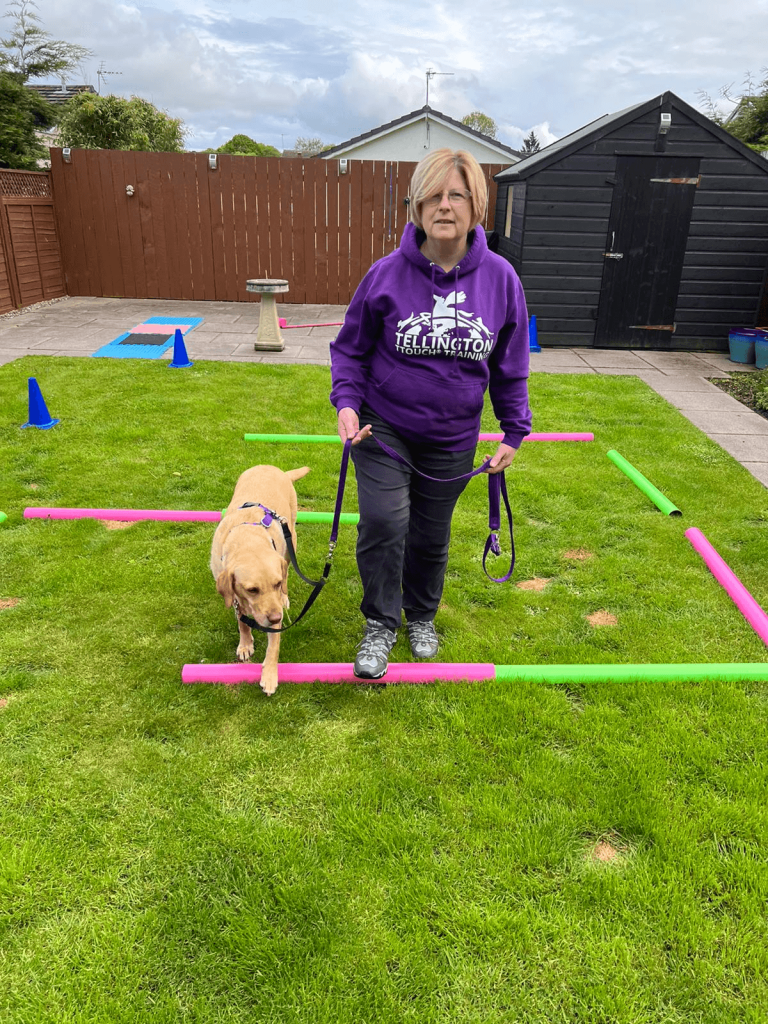
Tellington TTouch is a kind, gentle approach to the way we work with animals, Linda Tellington Jones developed Tellington TTouch over 40 years ago and it is now practiced all over the world by trainers, therapists, groomers, people working in rescue shelters, vets and vet nurses.
Linda, a great horse woman and trainer, developed the work while she was searching for a way to help the rider of the horse improve their posture. Linda had come to realise that the rider’s posture effected the way the horse moved, and she was looking for ways to help the horse move more efficiently. Linda knew even then that posture effects behaviour and it was while she was studying the Feldenkrais Method of awareness of movement to enhance balance and athletic ability that her intuition led her to develop Tellington TTouch. She had been working with a horse who had been labelled as difficult, she intuitively laid her hands on the horse, where she felt tension and began moving the skin in circles, this had a dramatic effect on the horse for the better and so together with her sister Robyn Hood, they began to perfect the TTouches and groundwork exercises we know today.
The Tellington TTouch Method can be used on any animal and Linda worked on a wide range of animals, from horses to dogs, cats, wildlife, birds, and zoo animals. The TTouches were named after some of the animals of whom the touches have been developed on. The names help to describe the touches so we can remember how to do them, for instance the Python TTouch was used to help a python at San Diego Zoo called Joyce. Joyce was an eleven foot long Burmese Python who had a lung infection, Linda started doing small circular touches on Joyce, but she seemed uncomfortable with the touch, so Linda started doing gentle lifts of her skin underneath her body to stimulate her lungs, Joyce stretched out her full length when Joyce was finished, she seemed to get some relief from the lifts. Clouded Leopard was named so after Linda used this touch to help a leopard cub who had been abandoned by its mother, the young leopard cub had started sucking its legs and kneading its paws in distress. Linda started doing the circular touches along it’s muzzle and down the legs to its paws. The touches on the mouth helped with her emotional distress and the touches down the legs and paws was to bring back the feeling in this part of the body. The clouded part was named so to be as light as a cloud and the touch itself you hold your hand like in the shape of a paw.
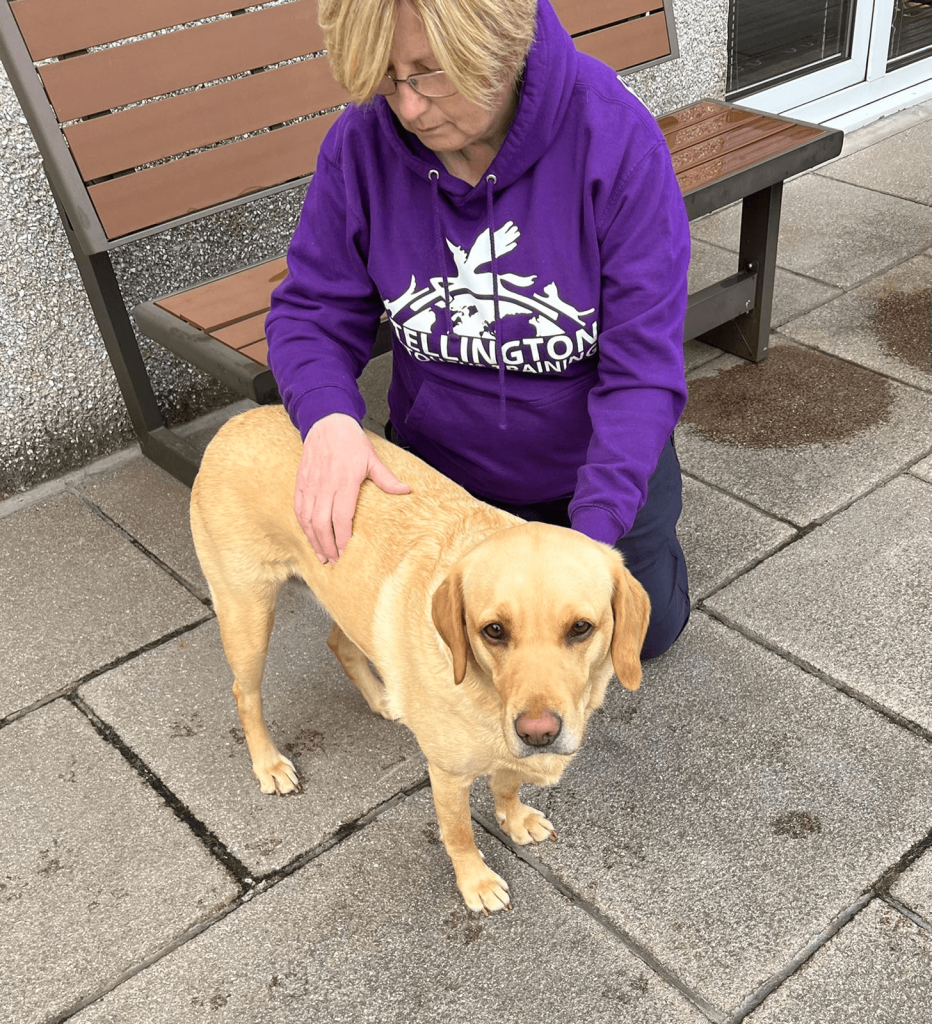
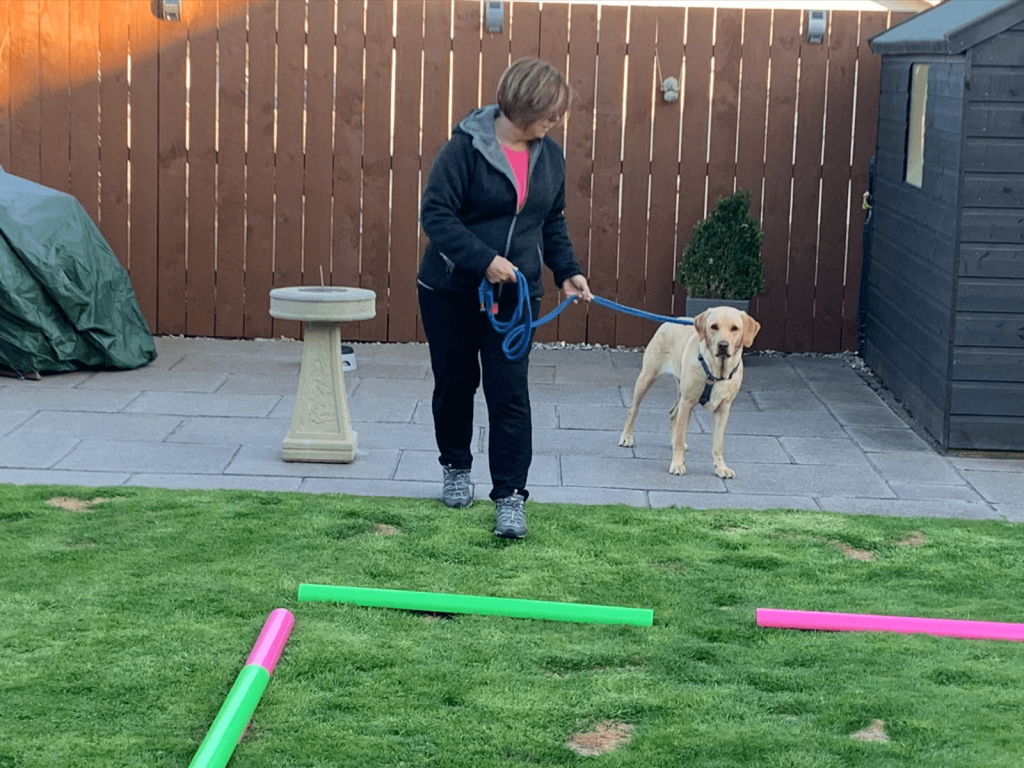
The TTouches have been known to release tension, speed up healing and release feel good endorphins. The extra T stands for Trust.
We have a saying in Tellington TTouch, Less is More, that’s because these TTouches and leading exercises are powerful, the TTouches awaken the nervous system and renew the cells in the body. There have been scientific studies done on the effects these touches have on lowering adrenaline, measuring pulse, brainwaves patterns and blood cortisol levels. You can find the results from these research studies on TTouch.com
Observation is an important part of Tellington TTouch, if we don’t observe before and after then how would we know if there is any change. By observing how the dog moves, if he avoids walking on any textures, how they hold their posture, any coat patterns, changes in shade or texture of the coat and temperature of the skin we can begin to learn more about the dog and how we are going to help them by improving circulation.
Groundwork exercises through what we call a confidence course can improve proprioception, coordination and balance. This may be walking over poles or in and out of weave cones, walking on different surfaces. These exercises are done slowly and mindfully with the dog wearing a harness with two connections for the lead to attach so the handler can guide the dog and have more influence to help the dog move in balance.
Balancing body and mind are essential in changing behaviour in a positive way.
We can also use other equipment to help us such as a wrap placed carefully on the dog in different configurations, the wrap is an Ace bandage. The aim is to help the dog to feel more secure and aware of their body, for some dogs is beneficial especially when they have no awareness of where their body is in space. For touch sensitive dogs, we can use different tools to touch them with, giving the dog a new experience if they have had the learning experience of being handled roughly by hands, these may be soft paint brushes or soft mitts, sponges or a wand, really you could use your imagination, so long as the tool you use is gentle and will not harm the dog and you are mindful of your approach.
The Tellington TTouch approach looks at the dog as a whole, mentally, physically, and emotionally to peel back the layers of the behaviour and start to help at the root cause then laying the foundations to build confidence and trust between handler and dog , strengthening self-control, self-awareness and self-carriage to improve confidence and therefore behaviour so the dog can begin to instinctively act instead of react in response to stimuli in their environment.
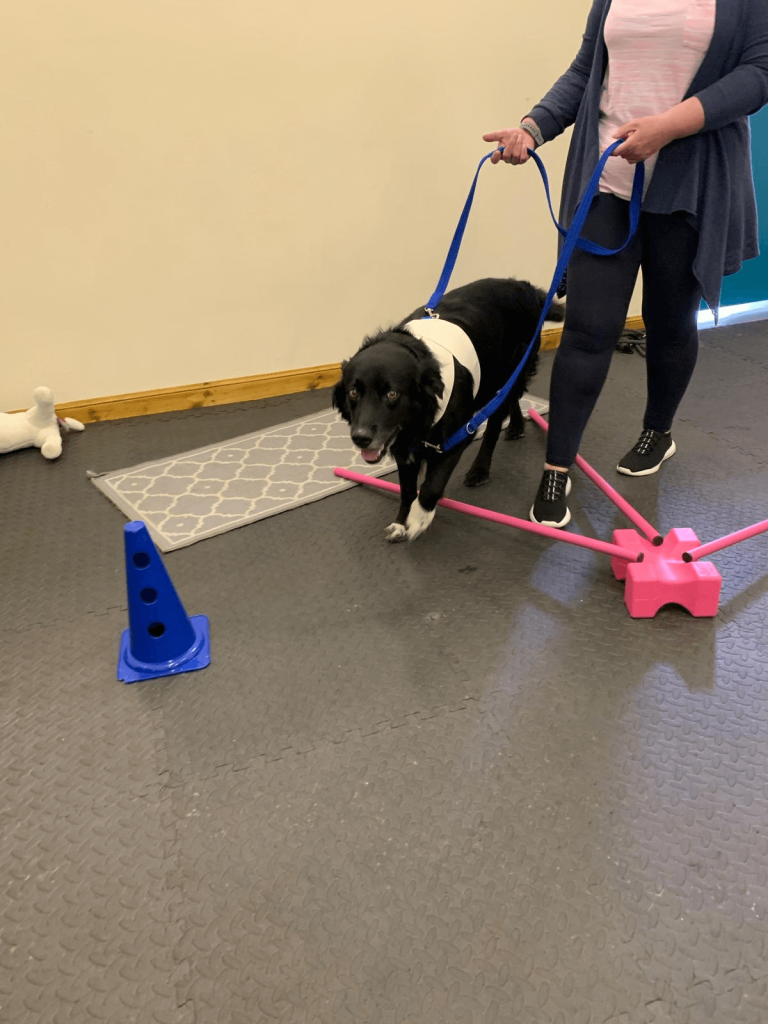
Introduction to Tellington TTouches
While doing TTouches, we are not doing them to the dog but with the dog. We give the dog the choice of if they feel comfortable with our touch.
TTouches have many benefits.
They can calm or stimulate a nervous dog, release tension in the body, or speed up healing by enhancing cellular communication to support the potential of the body to repair itself.
When you touch your dog using the Tellington TTouches® you awaken the nervous system by touching them in a non-habitual way, touching your dog in a way in which they are not used to, this brings body awareness to the dog.
It is important that we are mindful of how we touch our dogs and that we are in a comfortable position ourselves, when we are holding tension ourselves in our bodies, it has a completely different sensation for the dog than if we are relaxed through the body. It may be a good idea to practice your touches on a friend or partner so you can get feedback before touching your dog. Remembering to breathe while you are touching your dog will soften your touch, preventing it from being an intense experience for your dog.
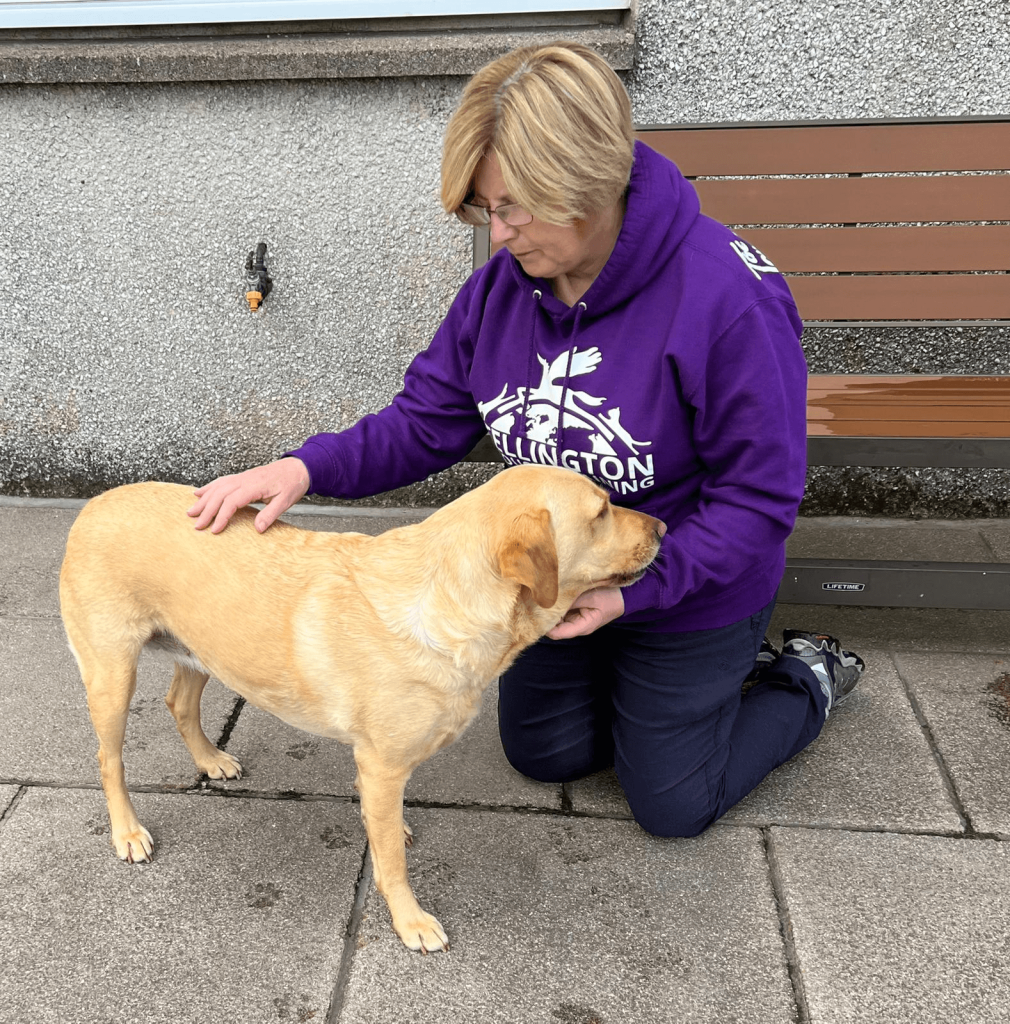
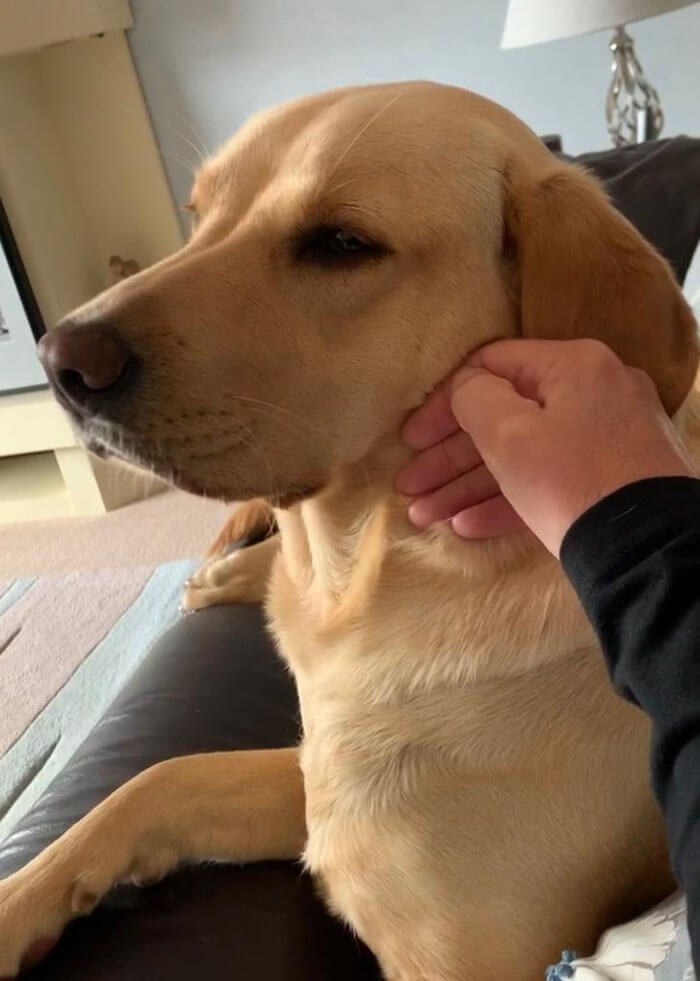
In TTouch we have a saying “Less is More”, being mindful of this by only doing a few touches and waiting for feedback from the dog is more effective, it allows the dog to process the sensation and then they may invite you to do more.
There are different types of TTouches.
Sliding TTouches where you slide your hands over the body.
Circular TTouches moving the skin only in a circle and a quarter.
Lifts where we support the skin in an upward movement and carry the skin back down again, we may add a pause after the upward movement before supporting the skin back down into place.
Tellington TTouch® is not a massage, and we don’t massage at a muscular level, nor do we manipulate anything in the body.
Sometimes introducing TTouches using the back of your hand can be less intrusive for the dog especially if they have a learning history of being grabbed or being grabbed by the collar.
This is where observations of your dog’s communication are very important. Your dog’s communication may be subtle, a polite dog may simply hold their breath or slightly lean away or look in the opposite direction if they feel uncomfortable with the touch. A dog who is more expressive may lip lick, obviously tense their body, yawn rapidly or step away.
On the other hand the dog may invite you to keep touching them, they may yawn softly, soften their eyes, paw you to keep touching them and some dogs may try to redirect your hand to touch them in another area, a dog who rolls on their back does not always want you to rub their tummy but may be redirecting you from touching an area in their body that feels uncomfortable.
Circular TTouches
While doing circular TTouches with your dog, your hand does not slide over the skin but instead moves the skin over the muscle.
Imagine the face of a clock, not a digital one, but a clock face, drawn on your skin.
Start at the six at the bottom of the clock and lift the skin as you move it in a circle around the clock face until you come back to the six, then continue further on until you come up to the nine.
This is what creates the circle and a quarter. Try to perfect the circle as much as possible, it is the act of continuing past the six that makes sure the circle is complete.
This touch is usually done in a clockwise direction, but some dogs prefer this touch to be done in an anti-clockwise direction or some people may find it easier to do the touch in this direction.
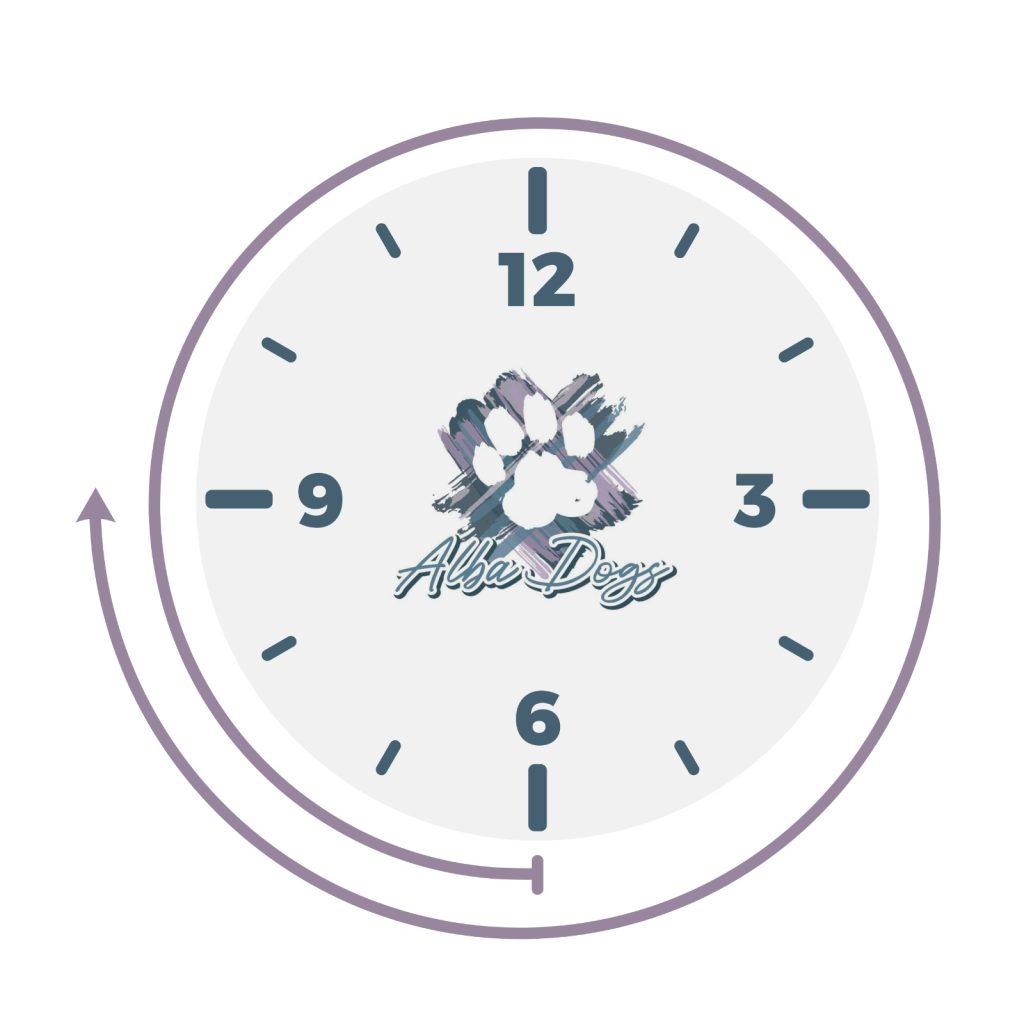
There are different pressure scales from 1-4 for dogs.
Pressure No 1
This is the lightest pressure and to get some sense of this pressure, support your bent elbow with one hand, and with the other, rest your thumb on your cheek, now use your finger pads to gently move the skin on your eye lid in a circle and a quarter.
Repeat the same circle with the same pressure on your arm and notice there is almost no indentation in your skin with No1 Pressure
Pressure No 3
To feel Pressure No 3, move your thumb slightly further down and place the pads of your fingers on the skin just above your cheek bone, the soft skin under your eye and feel the circle touch there.
Again, repeat the same pressure of touch on your arm and observe the indentation on your skin.
Pressure No 2 is between No 1 and No 3
You will probably never use Pressure No 4
Play about with the different pressures to find what is right for you and your dog. When working with an injury or inflammation use less pressure No 1 or 2 are enough and work around the injury and inflammation and not directly on it.
No 3 is a very common pressure.
Once you are more familiar with TTouch you will know instinctively the pressure that are best for the situation.
Pay attention to the tempo of your touch, the time it takes to move the skin in a circle and a quarter. Using slow circles, about one second circles are affective for reducing swellings and relieving pain. Use faster circles to stimulate a dog and slower circles when you want to settle a dog.
Mindful Pause
You can pause after the circle and a quarter touch and sponge your fingers or hand off and then slide your hand along the body and do another circle and a quarter and pause again. The mindful Pause helps the dog to process your touch after all it is has been said by musicians that it is “the space between the music that makes the noise”.
Connecting the TTouches
TTouches can be done all over the dog’s body. Rather than randomly skipping from area to area, it can be better to work in lines with a gentle slide along the dog’s body from TTouch to TTouch, generally from front to back of the dog’s body. However, when working on painful, sensitive, or injured areas, do not connect the circles. Instead sponge your fingers off the body gently and make a smooth move through the air to connect again gently with the skin and do another circle and a quarter.
The dog can be standing, sitting, or lying down.
Make sure you are in a comfortable position yourself and you are not leaning or stretching over the dog as this will have a different sensation for the dog. Leaning over your dog may worry them.
You may have to support your dog by placing your hand gently on their chest while doing the TTouches with the other, some dogs feel more secure when you have two hands on them but for others it may be too much for them to experience and one hand is more acceptable, always allow the dog room to exit if they must have their own space and never stop them from moving away.
Be mindful of your own breathing. We tend to hold our breath while concentrating on doing something new or trying to do it the right way, so breathe.
Watch for any feedback from your dog. If your dog moves away or leans away or even just a head turn, they may be telling you that they are uncomfortable with you touching in a particular area. Your dog may hold their breath momentarily or their breathing may escalate. If this happens, STOP touching in that area and go back to where your dog was comfortable with your touch.

A Selection of TTouches
This is the basic circle and a quarter, the other circular TTouches were developed from this touch.
Linda had been asked to help a leopard cub at Los Angeles Zoo, the cub had been abandoned by its mother and was showing signs of distress by sucking her leg and kneading her paws continuously. Linda began by doing small circles along the cub’s mouth to help with her emotional upset of not having her mother and then began some very light circles down her legs to her paws to help her relax and to bring a new feeling to her paws. “Clouded” came from the very light touches she used like “as light as a cloud” and the “Leopard” stands for the pressure, a leopard is very strong but then very light on their on their feet, the Clouded Leopard TTouch can be a very light touch or a strong touch depending on the animal, where on the body and the reason the TTouch is being used for.
All the TTouches have names that have been developed after the animal the touch was used on or what animal the movement of the TTouch would remind you of.
How to;
Place your hand with your fingers slightly curved on your dog’s body. Keep your fingers lightly together and move the skin in a circle and a quarter. Your thumb rests on the dog’s body to stabilise your hand and establish a connection with your fingers. Keep your wrist straight and as flexible as possible. Your fingers, hand, arm, and shoulders should be relaxed. You can put your other hand on the dog for supporting yourself as in your own balance and to support your dog if this is appropriate for your dog. Every dog is different, and you will have to experiment with what your dog finds comfortable, either one hand on their body or two hands.
The Clouded Leopard TTouch is effective for nervous or anxious dogs. It improves coordination and helps dogs with neurological issues.
You can use this TTouch anywhere on the dog’s body. I have used it on front of a nervous dog’s chest at the beginning of a bodywork session, you can also use connecting Clouded Leopard TTouches along the sides of the dog’s body to bring awareness.
Zebra TTouch is a sliding touch, if done quickly it can speed up respiration and heart rate, if done slowly it can slow respiration and heart rate. If your dog is anxious and panting, you may have to start this touch quite fast and then slow it down meeting the dog at where they are emotionally and making the change slowly will be more beneficial than trying to slow the dog down suddenly.
This TTouch is good for nervous or anxious dogs because it connects the different parts of the body, often dogs who are in this emotional state are not aware of their body and by connecting the body and creating awareness in the nervous system it engages the parasympathetic nervous system to relax tension in the muscles and improve circulation.
We do TTouches with the dog and not to the dog always being respectful of having the dog’s consent to touch in this way. If your dog leans away, starts to lip lick or even steps away you would always stop what you are doing.
Always be in a comfortable position yourself because if it is awkward and you are leaning over your dog, you may be carrying tension in your own body making your touch feel uncomfortable or irritable for your dog. Being mindful of yourself and how you touch will make your touch softer, remember to breath while touching your dog because we tend to hold our breath while concentrating ourselves, try touching rhythmically when doing the Zebra TTouch.

How To:
Stand or sit side on to your dog and when you start the touch put your arm over your dog’s body without leaning your body over the dog. This will be less threatening for your dog.
With your fingers close together, place on top of your dog’s shoulder and slide your hand down your dog’s body, try not to put any weight in your hand as you do this, as you slide your hand down open and spread your fingers, as you slide your hand back up towards your dog’s spine close your fingers. You can pause here before sliding your hand down again but this time a little further along your dog’s body, like a zigzag.
Zigzag along your dog’s body from shoulder to hindquarters. It may help to imagine you are following the stripes on a zebra.
Your dog can be sitting, standing, or lying down.
You can do this touch on one side or go from one side to the other on your dog’s body.
Watch for your dog’s reaction and if they step away as you start to touch them on their hindquarters, let them move off and take a mental note of this, it may be an area of you dog’s body that is of concern for them. If they have stepped to the side but not walked off, go back to touching your dog where they found it acceptable for you to touch.
This doesn’t mean that you are never going to touch the dog on the hindquarters again, but you may randomly add a touch in every now and then and watch for their reaction but always go back to what is comfortable for your dog.
This is a good touch for when you are waiting at the vets or settling your dog during training classes.
Always remember that you are working with your dog’s nervous system and if you keep touching for too long, the nervous system will simply shut off and the sensation of the touch will be useless “Less Is More” when using TTouches. In the beginning your dog will not be used to being touched in this way so only do a few slides and wait for your dog’s response and then build up from there, touching for short periods of time has far more benefits.
The second T in TTouch stands for Trust, building Trust with your dog brings a deeper connection and a better understanding between dog and handler as you start to learn the subtle communication in their body language.
The intention of using the TTouches is to bring awareness so the dog can use their thinking mind and not their reactive mind by activating new neural pathways to the brain with the potential to learn. When we touch the dog in this way, we release feel good hormones in the body, these include serotonin, oxytocin and dopamine changing how our dog feels emotionally with them experiencing feeling of happiness, relaxation improving mood and lowering stress levels.
The Python TTouch is from the family of lifting the skin TTouches. You carry the skin upwards gently, pause and support the skin to come back down again.
The Python Lift relaxes and calms and can be helpful for shy, tense, hyperactive or uncoordinated dogs.
A dog who is fearful, tense, or hyperactive will have limited awareness of their body and may not have the ability to move properly.
The Python TTouch will help them to feel grounded, promoting mental, emotional, and physical balance.
The warmth of your hand while doing Python TTouch can have a soothing and relaxing effect whilst increasing circulation.
How to;
Place your hand flat on the body and gently move the skin upwards while exhaling yourself, pause for a second, then slowly support the skin to come back down into place while inhaling.
If you exhale when you lift the skin, there is less chance of you tensing and pushing or forcing the skin upwards.
Try to spend twice as long allowing the skin to come back down as this will have an even greater effect.
You may need to support the dog with your other hand, or you may use two hands to do the touch, one on either side of the leg.
When doing the touch on the leg, slide down about one half inch after each lift until you gently slide your hand off the paw.
The Python TTouch was named after Joyce, an eleven-foot-long Burmese Python that Linda Tellington Jones worked on for a demonstration at San Diego Zoo in California. Joyce had suffered from recurring pneumonia every spring. Linda instinctively did slow lifts under Joyce’s body to stimulate her lungs. After a few minutes Joyce stretched out to her full length and then completely relaxed.
People often tell me that their dog’s love having their ears rubbed or stroked but wouldn’t it be fabulous if we could add meaning to this enjoyable touch.
Apart from the touch releasing oxytocin in both you and your dog there are many reasons as to why touching your dog’s ears can be beneficial, in fact many a dog has been saved while waiting to get appropriate help at the vet by their person stoking their ears. Your dog has many acupressure points in their ear relating to different parts of their body and right at the tip they have a shock point and if the dog has suffered a trauma or is sick by gently stroking their ears you may prevent the dog from going into shock. Stroking the ears also appears to balance the immune system and support the ability for the body to heal.
How Cool Is That!
But there is more information concerning the TTouch Ear Work.
Stroking the ear slowly will calm an excited or hyperactive dog by slowing down respiration and heart rate and stroking fast will help to activate a dog who is lethargic by speeding up the respiration and heartrate.
A dog who may be in fight or flight reflex, their nervous system being in the sympathetic nervous system, may have cold ear tips, this may be accompanied with cold paws and warmer or cooler areas on the hindquarters. This is because all the blood is flowing to the big muscle groups and vital organs ready for fight or flight by stroking your dog’s ears you will improve circulation, activate the limbic system which will affect the emotions.
Dogs who have noise sensitivities or suffer from digestive disorders or travel sickness will hold tension in their ears. These dogs may also carry tension across the top of the head as nothing in the body works in isolation and everything is connected. These dogs may be quick to be aroused.
Dogs whose ears are up and forward may be reactive, have little attention span and be distracted by movement.
When the ears look to be close together on top of the head, the dog may get excited easily and hold tension at the base of the ear.
Folded ears may indicate shyness or nervousness, these dogs can also be noise sensitive and can also hold tension in their hindquarters.
Dogs who have ears that look uneven may have tension in the neck and jaw and may not like you to touch the top of their head or handle their collar.
Dogs who have tension in the ears and top of the head may have heat in the forehead, in Traditional Chinese Medicine the Liver is associated with the top of the head and anger is one of the emotions of the liver, this may be accompanied with red gums, dogs who have this tension pattern should be handled very carefully being mindful that they may react quickly to movement.
How to do TTouch Ear Work.
You may have to stabilise the opposite side of the dog’s head but then again, some dogs don’t like two hands on them so watch for feedback from your dog. With the other hand place your hand under the ear but with your thumb on top. Gently stroke the ear with your thumb from the base of the ear to the tip. Cover all the area of the ear with gentle strokes.
If the dog’s ears are upright, stroke them in the direction in which they lie, if they are floppy, you may hold them out horizontal, so you don’t pull on them, if your dog has long hair stroke to the end of the hair being careful to nor tug on the ear.
Some dogs may not like you touching their ears if they are holding tension in this area, you can start by gently cupping the ear in your hand and moving the ear in a circle and a quarter, they might find this more comforting.
You can also start with little TTouches or strokes beside the ear and work your way towards the ear.
Tellington TTouch® Groundwork
Tellington TTouch® Groundwork looks a little like an agility course, there are a series of elements for the handler and dog to walk through slowly and mindfully, unlike an agility course where the handler and dog run through at great speed. Of course, running through an agility course with speed and accuracy takes training and a level of obedience from dog and handler, not forgetting the close partnership that is formed between dog and handler to be able to run the course to the best of their ability.
An agility dog will have developed good coordination and balance and be able to focus while moving at speed, for a dog who may feel unbalanced mentally, emotionally, and physically, this would be impossible for the dog to accomplish.
For these dogs who need support, walking through a course to gain their confidence, build on their coordination, self-carriage, and focus, moving slowly and mindfully to slow down their learning experience, help them to be more self-aware, aware of where their body is moving in space can help to improve on unwanted or reactive behaviour.
The Tellington TTouch® Groundwork course has been developed to help every dog, old, young, dogs who lack confidence, dogs who react quickly barking and lunging, dogs who may be recovering from an injury or to helps sporting dogs have more fluency to their movement.
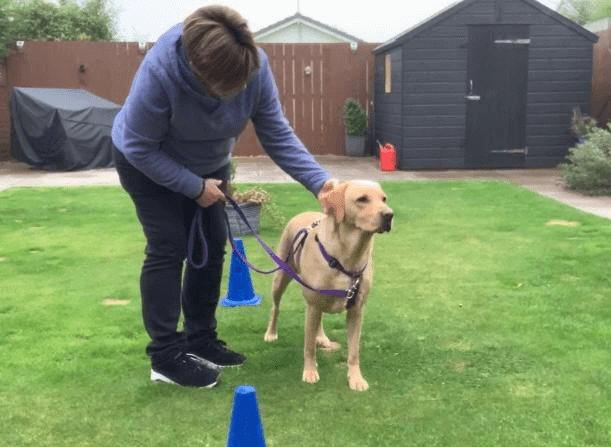
A dog is never coerced into walking over or through something they mind find difficult but given the choice. When a dog is reluctant to experience a certain part of the Groundwork, it is up to us to ask the question of why, to data gather what is happening in the environment, how the dog is moving through their body and how the handler has positioned themselves while walking beside and handling the lead. Then by using all the information we have gathered we can start to slow down the dogs learning to determine what they do find easy and build on this slowly in small steps so the dog can be the best that they can be. If after gathering all our information and we feel there needs to be further investigation, then we have a lot of information along side other observations such as coat patterns to take along to a Vet. Only a Vet can diagnose a problem.
For most dogs, walking through the Confidence Course as Groundwork is often referred to, improves flexibility in movement, strengthens proprioception (where the body is moving in space), enhances balance and coordination. This in turn helps the dog to slow down their thinking and they begin to stop and think instead of merely react.
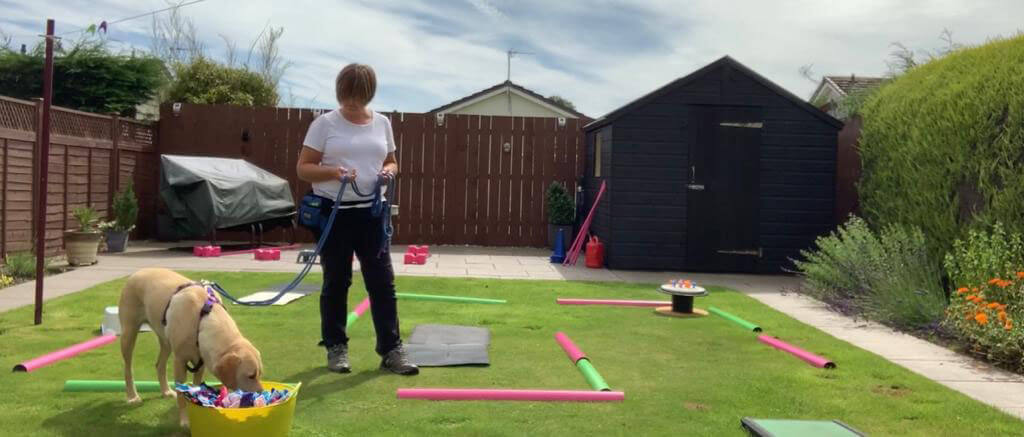
What is included in the Confidence course?
Nothing is too complicated, and the elements are introduced slowly and only a few at a time. The elements that would be included in a Confidence Course would be.
Surfaces: These are different textures for the dog to walk over, they can be raised surfaces or laid flat on the ground. The different textures could be an old bathmat or towel, yoga mat, flat piece of cardboard, bubble wrap or different carpet samples. For raised surfaces you could use a plank of wood (provided it is safe to walk over and not wobbly in case the dog falls off), I use an old dog ramp. The surfaces give the dog a different sensory experience on their paws and helps them to be more aware of where they are placing their paws.
Poles: These could be poles laid on the ground or raised slightly off the ground, you could only raise one side to give the dog the experience of using his eye/paw coordination. If you don’t have poles, you can use guttering or broom handles, long pieces of rope. Walking over poles will help the dog to lower their head and release tension in their neck, shoulders and all the way down the spine, engaging the hindquarters.
You can place the poles in a fan shape to help the dog to turn through their neck and ribcage. Dogs who are reactive and lung forward are often tight through the ribcage.
Also place poles in a zigzag, that way you can walk down through the zigzag to improve moving from one side to the other or you can simply walk over them too.
Cones: you can walk your dog in and out of weave cones, if you don’t have cones, plant pots or old bricks that are lying about or even tin cans can just as easily be set out for you to walk in and out of with your dog. Walking in both directions helps the dog to shift their weight evenly from one side to the other. You may find that your dog is stiffer in their movement when turning in one direction and not as able to turn through their neck or ribcage, if this is the case then move the cones further apart to allow the dog to move in a larger curve. When walking our dogs, we tend to just change direction quickly, we forget that our dog has four legs and a longer body and so needs time to make a turn.
Walking a dog in an s-shape can be very calming for them.
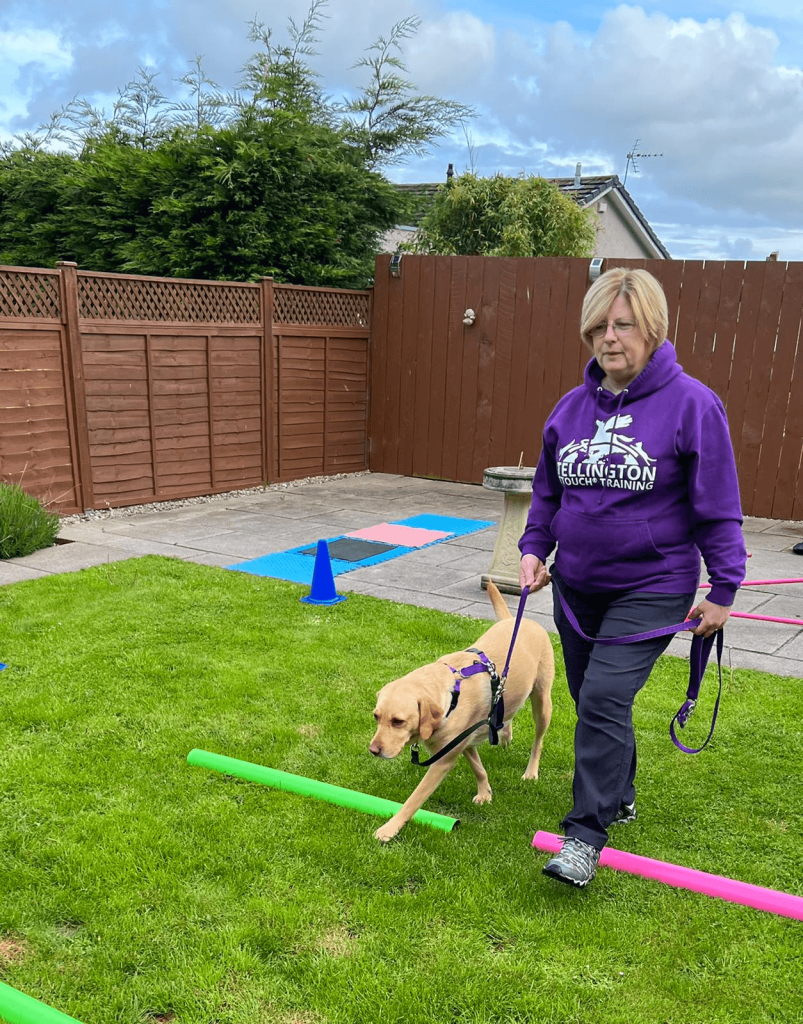
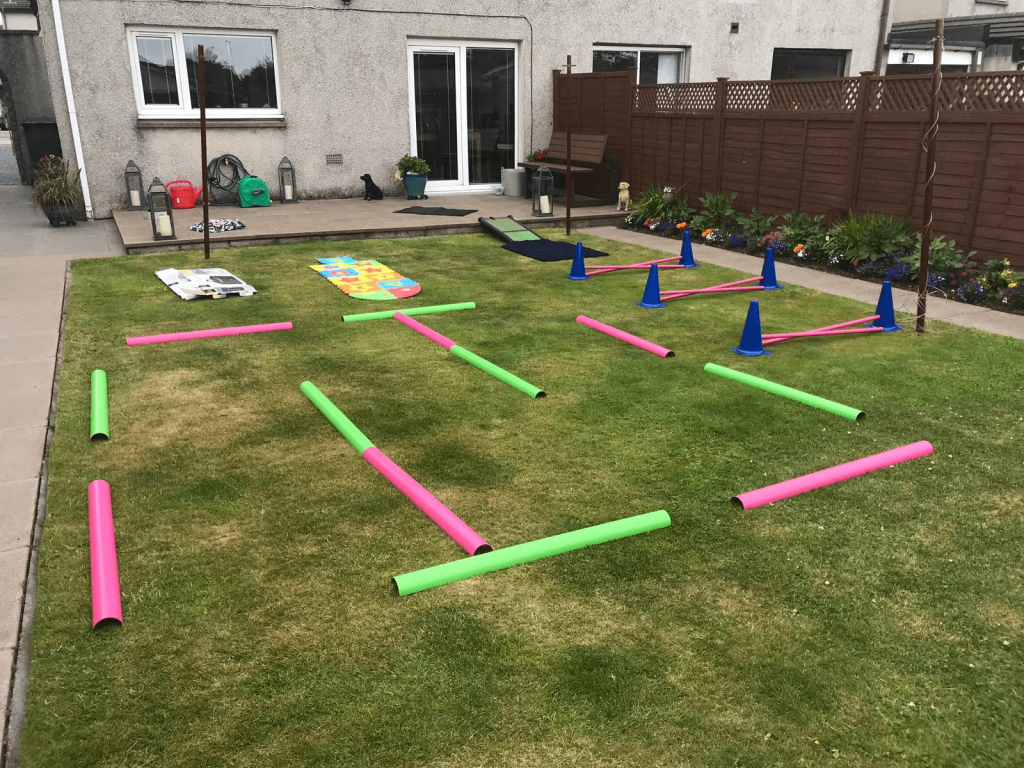
Labyrinth: You can use poles, guttering, pieces of rope to set out a labyrinth. Place them in a way that you walk into the labyrinth and then walk out again. You can walk in and stop before the turn and do a TTouch with your dog before making the turn, this will help the dog to be more considered when turning. You can add surfaces on the ground for the dog to step on too.
Walking through the Groundwork is as much about your lead handling skills, balance, and position too. It is your signals that are part of the communication between dog and handler, you are guiding the dog. Slowing down your movement and being more aware of your communication will help set the dog up to be the best that they can be at moving through the series of elements.
Equipment is another important factor, wearing the right fitting harness with two rings, one on the chest and one on the back for the lead to connect to will help to centre the dogs balance and be easier for you to guide the dog. A well-fitting harness that does not alter the dog’s natural gait by restricting movement in the shoulder with straps coming straight across the chest, a harness that has a y-shaped front gives the dog the opportunity to take a full stride forward with the front limbs. Using a Freedom handle on the lead for you to hold also helps to take the tension out of the lead giving your dog a relaxed feeling as they walk beside you. Some dogs find it easier while wearing a Connector attached to the front and back ring of the harness and the lead then attached to the Connector so it can slide back and fore smoothly as the dog moves, this gives the dog the experience of being on a longer lead and often they can find their balance easier when given space to do so.
There are so many choices of TTouches, different elements and how we can set them up, different equipment and leading skills to explore while going through Tellington TTouch® Training, if you gently feel your way of what is working for your dog and what is not you soon become to realise that you are developing a new understanding of your dog, learning how to communicate on a new level and your dog will begin to understand that you are Listening To Their Whispers. They don’t have to Shout out their concerns because you can now adjust what you are doing to help them cope. Your dogs nervous system has now calmed and their response will not be as explosive as they begin to think instead of merely react. This is what develops Trust. The second T in TTouch stands for Trust.
